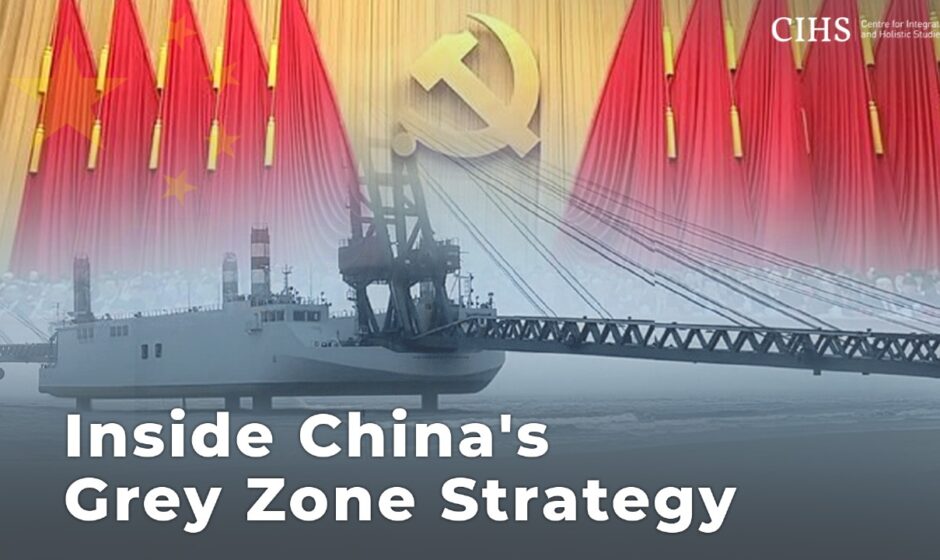Rahul Pawa
In South China Sea, grey zone tactics unfold with laser-focused intent. Watching the PLA Navy’s manoeuvres or the maritime militia’s presence can, at times, feel like staring at a chessboard whose pieces inch forward one measured square at a time.
The sight of special barges looming by the docks in Zhanjiang, China, went unnoticed by many who passed them on their daily commutes. To casual observers, these hulking platforms seemed little more than routine maritime fixtures. But for those with their eyes fixed on the shadows of international geopolitics, these barges signalled something far more ominous: a finely tuned exercise by the People’s Liberation Army (PLA) in what appeared to be over-the-shore logistics drills for a future military landing. In hushed circles in Taipei, Washington, Delhi and capitals across Asia, the question was no longer if China was meticulously preparing itself for conflict, but rather how it used the blurred space between war and peace to move closer to its global aspirations.

In recent years, Chinese Communist Party (CCP) has demonstrated a distinct flair for “grey zone” strategies—actions that straddle the threshold between open conflict and the calm of peacetime. This approach is not entirely new; historical powers have long tested their adversaries with salami-slicing tactics, never crossing the bright red line that might spark a full-scale clash. Yet what sets the CCP apart is its calculated synchrony of economic, diplomatic, maritime, and cyber manoeuvres, pushing its objectives in precise increments. In effect, Beijing has mastered the subtlety of wrestling advantage while making it appear that the match has barely begun.
In South China Sea, these grey zone tactics unfold with laser-focused intent. Watching the PLA Navy’s manoeuvres or the maritime militia’s presence can, at times, feel like staring at a chessboard whose pieces inch forward one measured square at a time. When disputes arise, the CCP often deploys fishing fleets that function like unofficial patrols, creating friction against neighbours like Vietnam or the Philippines. Although these fishing vessels seem harmless at a glance, their real purpose is to project CCP influence and thwart regional rivals from fully exercising their own sovereignty. Beijing’s “nine-dash line” claims—rejected as baseless by a United Nations Convention on the Law of the Sea (UNCLOS) arbitration panel—illustrate its sweeping claim over nearly the entire South China Sea. Yet China treats that ruling as little more than background noise. It has advanced its position through repeated harassment of Philippine resupply missions, demonstrating how a large naval fleet is not always necessary to assert dominance.
Last year, when Philippine efforts to resupply the rusted BRP Sierra Madre near the Second Thomas Shoal were impeded by China’s Coast Guard and maritime militia. An agreement to ease tensions was eventually reached, but China then turned its gaze toward the Scarborough and Sabina Shoals, employing a range of coercive tactics that skirted just below the threshold of outright military force. This is precisely the effectiveness of Beijing’s grey zone philosophy: the CCP can repeatedly test the resolve of its neighbours and the broader international community without triggering a major conflagration. Unchallenged, those incremental gains morph into accepted realities—often reinforced by a parallel campaign of disinformation and cyberattacks that sow confusion and shape public perception.
Indeed, the hallmark of the CCP’s grey zone strategy is its convergence with information operations. As the world has become more interconnected, data and narrative management have become invaluable pieces on the geopolitical chessboard. Taiwan’s National Security Bureau reported that Chinese agents circulated 60 percent more false or biased information in 2024 than in the previous year, an alarming trend that hints at a steady intensification of disinformation campaigns. It is, in effect, the other side of the same grey zone coin: while the PLA’s warships push deeper into contested waters, Beijing’s narratives undermine trust in democratic processes, making it that much harder for adversaries to mount a united response.
Another front where Beijing flexes its grey zone muscles lies in the economic realm—a domain where “carrots and sticks” often speak louder than gunboats. CCP’s massive market provides an enticing lure for many nations, encouraging them to tread lightly on issues Beijing holds dear. At the same time, the CCP is quick to punish countries that challenge its aims. Witness how trade restrictions, investment blacklists, and targeted boycotts are deployed whenever a state brushes too close to opposing CCP’s territorial ambitions or welcoming dissidents. Even patrolling maritime areas in dispute can shut down foreign economic opportunities: by swarming neighbourly waters with large fishing fleets, CCP can intimidate local companies into abandoning lucrative projects such as oil and gas extraction.
However, nowhere is the CCP’s grey zone approach more fraught with global tension than around Taiwan. For decades, Beijing has asserted that the island is a “breakaway province”, destined, eventually, for reunification—by force if necessary. Yet mounting a full-scale invasion comes with tremendous risk, both militarily and politically. Thus, CPC’s cross-strait strategy frequently focuses on intimidation and incremental pressure. Having declared its own Air Defense Identification Zone (ADIZ) over much of the East China Sea, the PLA has probed Taiwanese airspace with persistent sorties, testing and teasing the boundaries. Over the course of 2024, the PLA Navy stationed warships near Taiwan’s ADIZ, and by December that year, it conducted large-scale exercises with aviation and naval forces in an elaborate show of force. All of it served dual purposes: normalising frequent PLA military appearances in the region, and demonstrating that Taipei’s backers—chief among them the United States—may not muster the political will to intervene every time.
For the United States and its allies, especially Japan, the grey zone creates a double bind. Acting too robustly against each provocation risks an escalation that no one wants, while complacency allows Beijing’s inroads to solidify into indisputable facts on the ground—or, in this case, at sea. The art of Beijing’s game lies in how it calibrates pressure just below that flashpoint. By the time foreign powers muster the will to intervene, the CCP has typically moved on to new gains, leaving behind a patchwork of so-called “settled” issues that are no less unresolved than they were before.
It is becoming increasingly clear that this grey zone paradigm is not merely a transient strategy. Rather, it stands as a reflection of how Beijing perceives its rightful place in the world. Seeing itself as a natural hegemon, CCP is determined to attain that position through a combination of overt military might and more subtle infiltration, whether via maritime sabotage, economic blackmail, or narrative manipulation. The Zhanjiang logistics drills serve as a reminder that while the CCP appears comfortable in the land of half measures, it has never abandoned the possibility of a direct military takeover of Taiwan. The resources and political clout behind these preparations point toward a meticulously orchestrated operation rather than an improvised reaction.
So, the question for the world’s democracies is how to respond to a power that prefers to operate in murky waters. Policymakers are left to decide whether to enhance their own resilience in everything from cybersecurity to supply chain independence, or whether to engage in riskier head-to-head confrontations over contested atolls and seaways. Yet, burying one’s head in the sand only grants Beijing more time to claim, consolidate, and rewrite the narrative of contested zones. The grey zone, by design, thrives on divided attention and half-hearted commitments. The lines between war and peace have blurred, and no single tactic, no single act of defiance, is likely to reverse that dynamic overnight.
The special barges in Zhanjiang may vanish from public view in the coming weeks, either put to sea or transferred to another port. But the larger message they impart—CCP’s relentless pursuit of regional dominance via both open displays of military might and the quiet creep of grey zone tactics cannot be so easily tucked away. Whether one labels it salami-slicing or political warfare, the result remains the same: a slow, methodical encroachment that demands attention.
(Author is Research Director at Centre for Integrated and Holistic Studies, New Delhi based non-partisan think-tank)Inside China’s Grey Zone Strategy



